Collaborative beamforming technology always is used in large-scale antenna array to increase the energy efficiency of communication[1-2]. Multiple transmitters create a high directional beams to a distant receiver. But sometimes setting up a set of antenna arrays is not easy and timely. Wireless sensor network (WSN) is composed of a large number of miniature battery-powered sensor [3-6], and the sensor can monitor the environment and have the ability of data processing and wireless communication.
As sensor nodes are low cost and small size, those can be randomly allocated on the sea surface or other regions in many applications, such as the ocean current’s change, environment monitoring, and safety protection. Usually, senor nodes collect and transmit data to a base station [7], but the energy of a single sensor node is so low that it cannot communicate directly with the distant base stations [8].
What's more, considering for this case, thousands of sensornodes need to communicate with a long-distance base station. In addition, there are no base stations or aircrafts as the relay nodes. One of the effective ways to solve this problem is collaborative beamforming[9-11]. But for a long-distance transmission, hundreds of sensor nodes will be used. So event-triggered is a more effective way comparing with time-triggered.
In this paper, we propose an event-triggered clustering algorithm for collaborative beamforming long-distance transmission based on WSN. And clusterheads can communicate with each other to realize the data aggregation and sharing. Moreover, synchronizing the carrier phase is a key problem for collaborative beamforming [12-15]. Therefore, using the route of clustering can not only share data, but also synchronize the phase. Then we can set up a direct data transmission between the distant receiver and the sensor network. Through the link, we can not only realize the communication between the sensor network and long-diastance base station, but also be able to upload the measurement data gathered from the sensor network to the distant receiver. The network topology of CEWEC is shown in Fig. 1.
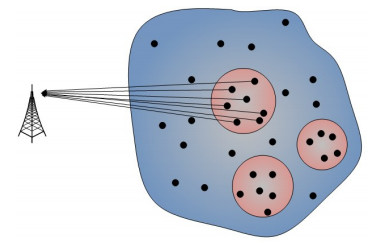
|
Figure 1 Network topology of CEWEC |
2 Related and Previous Work
Nowadays, there are many scholars researching on the clustering algorithm of WSN. LEACH[16] showed a good approximation of a proactive network protocol, which enable self-organization of large numbers of nodes. Even though the algorithm considered the chance of clusterhead election should be equal, it did not regard the cost of nodes is different in practice. HEED[17] proposed a hybrid, energy-efficient distributed clustering algorithm. It periodically selects clusterheads according to a hybrid of the node residual energy and a secondary parameter, such as the node proximity to its neighbors or the node degree. Furthermore, DWEHC [18] presented a distributed, weighted, energy-efficient hierarchical clustering algorithm. The clusterhead election is based on the weight that including the residual energy and the distance of nodes. EEMA [19] proposed a novel adaptive energy-efficient multi-layered architecture protocol for large-scale. It is good at data aggregation, increasing network lifetime, and reducing routing delay. But all of them make all the nodes in the area become either a clusterhead or a child, and it cannot ensure the number of nodes in a cluster. However, those clustering algorithm cannot satisfy the need of beamforming.
As the collaborative beamforming is becoming more popular and mature in array signal processing, the limitation of the large-scale antenna have been occurred[20]. In recent years, many of researchers have paid attention on the application about the collaborative beamforming in WSN. Barriac[12] discusses the synchronization of time and phase and analyses the effects of various sources of coordination error on the attained performance. But it only thinks about the position of nodes are fixed in the area and does not consider the clustering. Whereafter, Feng[1] firstly analyzed the data sharing in beamforming for WSN. Although the network model is simple, they proved that collaborative beamforming is energy-efficient when the sensor nodes are deployed far away from the base station and the energy consumed for data sharing has negligible effects on the network’s lifetime.
Based on those designs, the paper introduces an event-triggered energy-efficient clustering algorithm in collaborative beamforming. With this algorithm, largely random wireless sensor nodes can be effectively managed and reasonably used for long-distance data transmission.
3 An Collaborative, Event-Triggered, Weighted, Energy-Efficient Clustering AlgorithmFirstly, we describe the network model, the clustering structure and related concepts as the foundation of the algorithm, and then give our objectives.
3.1 Network ModelIn this section, we clarify the network model. We assume that there are hundreds or thousands nodes in the area of clustering. Also:
1) N nodes are randomly dispersed in a space and cannot be recharged after deployment.
2) Nodes are quasi-stationary.
3) Nodes have a certain communication range.
4) There is not a base station or an aircraft near the network.
5) Nodes are location aware, and they are equipped with the GPS deceives or they can get it from signal strength or direction.
6) Nodes’ energy consumption is not uniform.
We believe that the model and these assumptions widely suitable for most real wireless sensor network. In the model, the trigger node decides whether the cluster needs other nodes that are out of the trigger node’s communication range, depending on the node number within the range. If the number of nodes is enough to beamform, clustering will happen in the trigger node’s communication range. Otherwise, clusterheads will request more nodes to start.
After the clustering, data sharing in beamforming is necessary. The trigger node send data to its parent node (one of clusterhead), and then the clusterhead shares data with other clusterheads and their child nodes. Generally, the node’s position can be known via GPS or by other means.
3.2 Clustering StructureAfter running CEWEC, a clustered network has the features:
1) Clusterheads can communicate with each other without base station.
2) Due to the inherent characters of CEWEC, failure is allowed. But we have taken many measures to reduce the probability.
3) To save the energy of nodes and enhance the lifetime of network, only part of nodes are started. It will be allowed that a node which is not a clusterhead or a child node.
4) A parent node has a limited number of children.
3.3 Related ConceptsSome concepts used in CEWEC will be introduced in this part. In an area, given a set of wireless sensor nodes, those have the stationary energy.
1)Communication range, r
T(s) is the set of nodes lying inside the communication range of node s. Rc is the greatest distance from node s to T(s).
| ${{R}_{c}}\left( s \right)=\left\{ r|r=\max R\left( s, u \right), u\in T\left( s \right) \right\}$ | (1) |
2) Clusterhead’s neighbors
In CEWEC, only clusterheads can have neighbors. For a clusterhead H1, if there is another clusterhead own a minimum distance to H1, it will become the neighbor of H1.
3) Cluster range, R
R is the radius of a cluster, and expresses the distance from the farthest node inside a cluster to the trigger node. This is a statistical parameter according to the actual cluster.
4) Weight used in clusterhead election
The weight is the most important factor of clusterhead election, which is represented by my_w. It is defined in Eq. (2), where s represents a node in cluster; d(i, h) is the distance from node s to clusterhead h; d(i, h) is the distance from node s to the trigger node; Eresidual(s) is the residual energy in node s and Einitial(s) is the initial energy in node s.
| $W\left( s \right)=\frac{{{E}_{\text{residual}}}\left( s \right)}{{{E}_{\text{initial}}}\left( s \right)}\times \frac{1+\sum\limits_{h=0}^{n}{\left( {{d}_{\left( i, h \right)}} \right)}}{\left| {{d}_{\left( i, t \right)}}-\frac{r}{2} \right|}$ | (2) |
The primary goal of CEWEC is to insure clusterheads could directly communicate with each other. The carrier phase synchronization and the data sharing can be achieved in the absence or distance of base station. Based on this function, improving energy efficiency and prolong the lifetime of the network are the important factors for a clustering algorithm. Because the clusterhead needs to transmit and share all data from the trigger node, it will consume more energy than child nodes. Thus, the residual energy is one of key measurements for clusterhead election.On the other hand, the location of clusterhead in the cluster is very important. It would better locate near the half of the trigger node's communication range and uniform distributed.
5) Cluster’s level
To reduce the synchronization errors, each cluster can have three levels at most. The level of a node depends on its location and weight in the cluster. Fig. 2 shows a multilevel cluster generated by CEWEC, where T1 is the trigger node in the first level at first; H2~V5 are the clusterheads in the second level. V7~V8 are the children of H2 in the third level. Certainly, there are some nodes outside the cluster, such as N15, N16. They are waiting for the request to start.
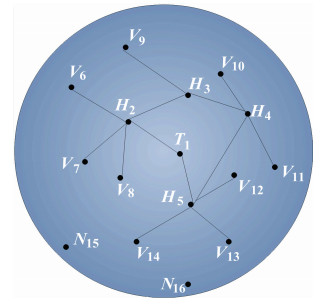
|
Figure 2 Levels in CEWEC |
6) my_range
In a cluster, each child node is needed to directly communicate with its parent node (one of clusterhead) and the communication distance is necessary to be known. Therefore, my_range is used to record the range. As shown in Fig. 2, from V6 to H2, my_range is calculated by
In CEWEC, event-triggered method will be used for start a clustering. When there is a node requiring to transmit data (my_event=1), it will start a clustering in its communication range. If not, all of nodes are waiting for the request (my_wait=1).
At the beginning, the trigger node broadcasts the information including its x and y coordinates, id, and the request to start the algorithm. id and x and y coordinates will be used for statistical treatment in subsequent process. If a node receiving a request to start when it is waiting, it returns a confirmation message and begins the clustering algorithm.
After running the algorithm, each of nodes in the cluster will have a set of communication nodes. The trigger node is in the first level at first, but finally it will become a child node and belong to a clusterhead in the third level. Thus, the data sharing will be achieved by clusterheads. The initial setting is -1 for my_level, which indicates that the node has not joined any cluster yet. As shown in Fig. 3, we explain how a node becomes a clusterhead or a child node.
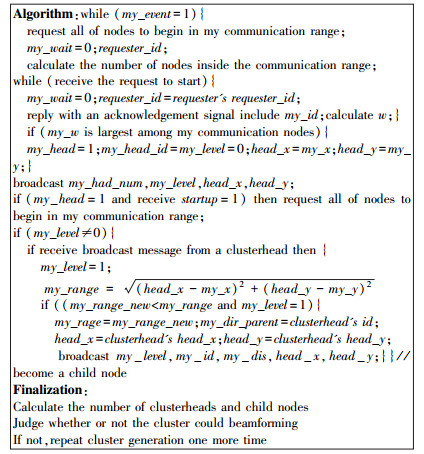
|
Figure 3 CEWEC |
Clusterhead: A node that has the largest weight among the trigger node’s communication range will become a clusterhead (my_head=1). Then those nodes with my_level=-1 can still become a clusterhead in the following iterations. Clusterheads need to broadcast its attribute information including its my_level, x (head_x), and y (head_y) and my_id.
Child node: A node will become a child node when it receives a request from a trigger node and does not become a clusterhead. There are two cases: a) When a node’s my_level=1 and it receives information from a clusterhead including my_level and x and y coordinates (head_x, head_y), the clusterhead will become the node’s parent node. Setting my_level=2 and calculating my_dis. b) When my_level=2, that means the node already has a parent node. If the node received a new clusterhead’s information and the new my_dis is less than the previous my_dis, the parent node would be changed.
Iteration: According to the distance from the sensor node to the long-distance base station, the protocol calculates the quantity of nodes and clusterheads which will be used for collaborative beamforming. If the number of nodes is not enough, the clustering will fail. Then the protocol would increase the number of iteration, but the maximums number of iterations is limited.
4 SimulationIn this section, we will analyze the process, success rate and energy efficiency of CEWEC. We use a WSN: separately setting 200-500 sensor nodes randomly deployed in the size of 250 m*250 m. Then we can verify the algorithm in multiple scenarios. The simulation parameters are shown in Table 1, where Eo is the initial energy; ETX and ERT are the power when a node transmitting or receiving 1bit data; Efs is the effective receiving power; Emp is the transmitting gain, and EDA is the data aggregation energy.
| Table 1 Simulation parameters |
4.1 The Clustering Process and Results
As shown in Fig. 4, when there is no data need to be uploaded, all nodes are in a state of waiting (my_event=0). The blue circle icon represents the node that is waiting for the request to start the algorithm (my_wait=1). When event occurs, the nodes that need to upload data change to be triangle icon. And the trigger node counts and starts nodes in its communication area. The started nodes are represented by black rectangles icon, as shown in Fig. 5.

|
Figure 4 The simulation scenarios of initialization (node-quantity=200) |
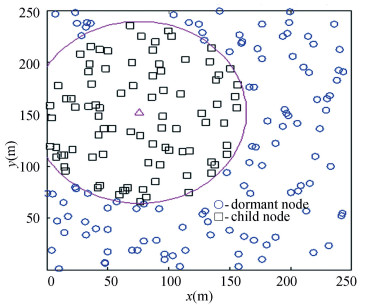
|
Figure 5 The simulation scenarios of node starts triggering(node-quantity=200) |
Figs. 6-8 separately show the clustering results in the area of 250 m*250 m when the node number is 200, 300, and 500. As shown in these graphs, in CEWEC, only to select nodes that are relatively near the trigger node to start. So it can avoid starting too many nodes, which causes a waste of resources and increases network lifetime. In Fig. 8, within the trigger node's communication range, the started node number can reach the requirement of expected number (100). So we can choose the clusterhead in the communication range, and do not request the clusterhead starts more nodes.
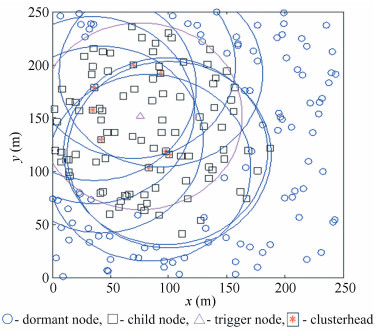
|
Figure 6 The simulation scenarios after clustering(node-quantity=200) |

|
Figure 7 The simulation scenarios after clustering(node-quantity=300) |
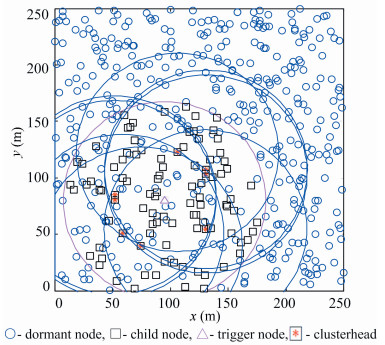
|
Figure 8 The simulation scenarios after clustering (node-quantity=300) |
4.2 The Success Rate of CEWEC Algorithm
Because there is no restriction of the size and the distribution of the network, inevitably there are some failing clustering situations occur, which is caused by gathering insufficient number of nodes or bad communication between clusterheads. But we have considered these factors and strived to make the failure rate lowest. Those events meeting the following conditions will be called cluster failure:
1) The nodes which are activated do not reach the requirement of the expected number;
2) The node that is activated is not included in any sub-cluster;
3) The Clusterhead can not communicate with its neighbors.
Table 2 shows in a field of size 250 m*250 m separately random distributing 200, 300, and 500 nodes, and count the failure rate for 5 000 times. It can be concluded that if the node number of the network is enough, the failure rate will be very low.
| Table 2 Failure rate of clustering(200, 300, 500) |
Certainly, when the number of clusterheads is constant, with the decreasing of node density, the failure rate will increase gradually. In this case, in order to improve the success rate, the number of the clusterheads will be added properly.
Fig. 9 shows the relationship between the success rate and the node density. Test number is 5 000, and the number of nodes varies from 200 to 500. Four curves are the results of six, seven, eight, and ten times iterations separately in the figure. Along with the increase of node density, the success rate gradually increases. And the increasing rate decreases gradually until close to 1. Furthermore, the increase of iteration times helps to improve the success rate, but the increasing of iteration times is accompanied by an increase in the clusterhead number. However, too much clusterheads are not conducive to the clusterhead synchronization and data sharing. So the iteration time cannot be too much.
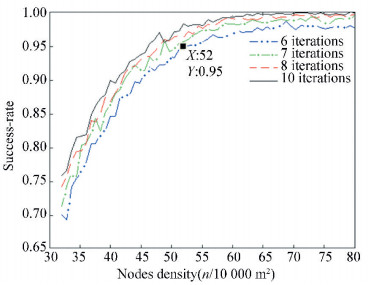
|
Figure 9 Success rate trend of CEWEC algoritm |
In the simulation, we choose the node density when the success rate is 95% as a sign of stopping network. When the success rate is 95%, the node density on the curve of six times iterations is the highest, and the condition of network stopping is the strictest. Therefore in the process of simulation, we use the node density in six times iterations and success rate is 95% as a symbol of whole network stopping. As shown in Fig. 9, the node density is 52/10 000 m2.
4.3 Energy Model SimulationIn order to prolong the lifetime of the network, the node energy considerations is added to the CEWEC algorithm. At the same time, in order to improve the success rate and weaken the influence of failure when the number of nodes is unavailable to the expected number, the CEWEC employs six iterations. If the trigger node cannot wake up enough nodes after six times iterations, then perform seventh, eighth until tenth iterations. Based on node communication and data processing in the CEWEC and the actual scenario, the node energy consumption model is designed.
Next, we discuss the relationship between the density of nodes and the cluster number, as shown in Figs. 10 and 11. The initial node number is 500 and test 100 times. Two curves respectively represent the node density of considering the energy and take no count of the energy in the CEWEC. We test the algorithm in the two cases. As shown in Fig. 10, the trigger node is fixed. When the triggering node energy is depleted, we select the new node to trigger.the trigger node is not fixed, random selection in the area, as shown in Fig. 11. In Fig. 10 the node density declines faster in the initial stage, while decreases faster at the later stage in Fig. 11. As can be seen from both of the graphs, with the increase of clustering times, the nodes energy is consumed continuously, the nodes begin to die gradually, and the nodes density decreases. Marking the coordinate of the node density is 52n/10 000 m2, iterated six times and 95% success rate as a symbol for the whole network to stop working. From the simulation results, it can be seen when considering the energy balance factor, the node density decreases more slowly and the total number of clustering is more with CEWEC method.

|
Figure 10 Nodes density at different triggering times (the trigger node is fixed) |

|
Figure 11 Nodes density at different triggering times(the trigger node is not fixed) |
5 Conclusions
This paper proposes an event-triggered energy-efficient clustering algorithm for data sharing and carrier phase synchronization in collaborative beamforming. It solves the problem of long-distance transmission without base stations and aircrafts in WSN. The results of simulations prove that CEWEC has a high success rate and can balance the consumption of energy. The proposed CEWEC algorithm also prolongs the lifetime of network. In addition, we believe that the combining of collaborative beamforming with WSN will become a new and popular way of remote communication in the future.
| [1] |
Feng J, Nimmagadda Y, Lu Yung-Hsiang, et al. Analysis of energy consumption on data sharing in beamforming for wireless sensor networks. Proceedings of 19th IEEE International Conference on Computer Communications and Networks.Piscataway:IEEE, 2010.757-760.
( 0) 0)
|
| [2] |
Celandroni N, Ferro E, Gotta A, et al. A survey of architectures and scenarios in satellite-based wirelesssensor networks: system design aspects.
International Journal of Satellite Communications and Networking, 2013 , 31 (1) : 1-38.
DOI:10.1002/sat.1019 ( 0) 0)
|
| [3] |
Siew Z W, Chin Y K, Kiring A, et al. Comparative study of various cluster formation algorithms in wireless sensor networks. Proceedings 2012 7th IEEE International Conference on Computing and Convergence Technology.Piscataway:IEEE, 2012.534-538
( 0) 0)
|
| [4] |
Benjamín Béjar Haro, Santiago Zazo, Daniel P. Palomar. energy efficient collaborative beamforming in wireless sensor networks.
IEEE Transactions on Signal Processing, 2014 , 63 : 496-510.
( 0) 0)
|
| [5] |
Ahmed M F A, Vorobyov S A. Collaborative beamforming for wireless sensor networks with Gaussian distributed sensor nodes.
IEEE Transactions on Wireless Communications, 2009 , 8 : 638-643.
DOI:10.1109/TWC.2009.071339 ( 0) 0)
|
| [6] |
Abd Malik N N N, Esa M, Yusof S K, et al. Intelligent circular collaborative beamforming array in wireless sensor network for efficient radiation. 2013 Asia-Pacific Microwave Conference Proceedings (APMC).Piscataway:IEEE, 2013.1009-1011. doi:10.1109/APMC.2013.6695006.
( 0) 0)
|
| [7] |
Abbasi A A, Younis M. A survey on clustering algorithms for wireless sensor networks.
Computer Communications, 2007 , 30 (14/15) : 2826-2841.
DOI:10.1016/j.comcom.2007.05.024 ( 0) 0)
|
| [8] |
Mark Perillo, Wendi Heinzelman. An integrated approach to sensor role selection.
IEEE Transactions On Mobile Computing, 2009 , 8 (5) : 709-720.
DOI:10.1109/TMC.2008.159 ( 0) 0)
|
| [9] |
Papalexidis N, Owens Walker T, Tummala M. An energy-efficient and distributed approach to beamforming in a wireless sensor network.Proceedings of 2008 42nd Asilomar Conference on Signals, Systems and Computers.Piscataway:IEEE, 2008. 878-881. doi:10.1109/ACSSC.2008.5074536.
( 0) 0)
|
| [10] |
Ahmed Mohammed F A, Vorobyov Sergiy A. Beampattern random behavior in wireless sensor networks with Gaussian distributed sensor nodes.IEEE Canadian Conference on Electrical and Computer Engineering. Piscataway:IEEE, 2008. 257-260.doi:10.1109/CCECE.2008.4564535.
( 0) 0)
|
| [11] |
Kalis A, Kanatas A G, Efthymoglou G P. A Co-operative beamforming solution for eliminating multi-hop communications in wireless sensor networks.
IEEE Journal on Selected Areas in Communications, 2010 , 28 (7) : 1055-1062.
DOI:10.1109/JSAC.2010.100910 ( 0) 0)
|
| [12] |
Barriac G, Mudumbai R, Madhow U. Distributed beamforming for information transfer in sensor networks. IEEE Third International Symposium on Information Processing in Sensor Networks. Piscataway:IEEE, 2004. 208-212. doi:10.1109/IPSN.2004.1307326.
( 0) 0)
|
| [13] |
Mudumbai R, Hespanha J, Madhow U, et al. Distributed transmit beamforming using feedback control.
IEEE Transactions On Information Theory, 2010 , 56 : 411-426.
DOI:10.1109/TIT.2009.2034786 ( 0) 0)
|
| [14] |
Richard Brown D, Vincent Poor H. Time-slotted round-trip carrier synchronization for distributed beamforming.
IEEE Transactions on Signal Processing, 2008 , 56 : 5630-5643.
DOI:10.1109/ACSSC.2007.4487540 ( 0) 0)
|
| [15] |
Berger S, Wittneben A. Carrier phase synchronization of multiple distributed nodes in a wireless network. 2007 IEEE 8th Workshop on Signal Processing Advances in Wireless Communications. Piscataway:IEEE, 2007. 375-379.doi:10.1109/SPAWC.2007.4401342.
( 0) 0)
|
| [16] |
Heinzelman W B, Chandrakasan A P, Balakrishnan H. An application-specific protocol architecture for wireless microsensor networks.
IEEE Transactions on Wireless Communications, 2002 , 1 (4) : 660-670.
DOI:10.1109/TWC.2002.804190 ( 0) 0)
|
| [17] |
Younis O, Fahmy S. HEED: a hybrid, energy-efficient, distributed clustering approach for ad hoc sensor networks.
IEEE Transactions on Mobile Computing, 2004 , 3 (4) : 366-379.
DOI:10.1109/TMC.2004.41 ( 0) 0)
|
| [18] |
Ping D, Holliday JoAnne, Celik A. Distributed energy-efficient hierarchical clustering for wireless sensor networks.DCOSS'05 Proceedings of the First IEEE international conference on Distributed Computing in Sensor Systems. Berlin, 2005.322-339.doi:10.1007/11502593_25.
( 0) 0)
|
| [19] |
Mehdi Afsar M. Effective data aggregation using a Hierarchical multi-layered scheme for large-scale sensor networks. IEEE 27th Canadian Conference on Electrical and Computer Engineering. Piscataway:IEEE, 2014.110-112.
( 0) 0)
|
| [20] |
Ochiai H, Mitran P, Poor H V. Collaborative beamforming for distributed wireless Ad Hoc sensor networks.
IEEE Transactions on Signal Processing, 2005 , 53 (11) : 4110-4124.
DOI:10.1109/TSP.2005.857028 ( 0) 0)
|
 2016, Vol. 23
2016, Vol. 23


